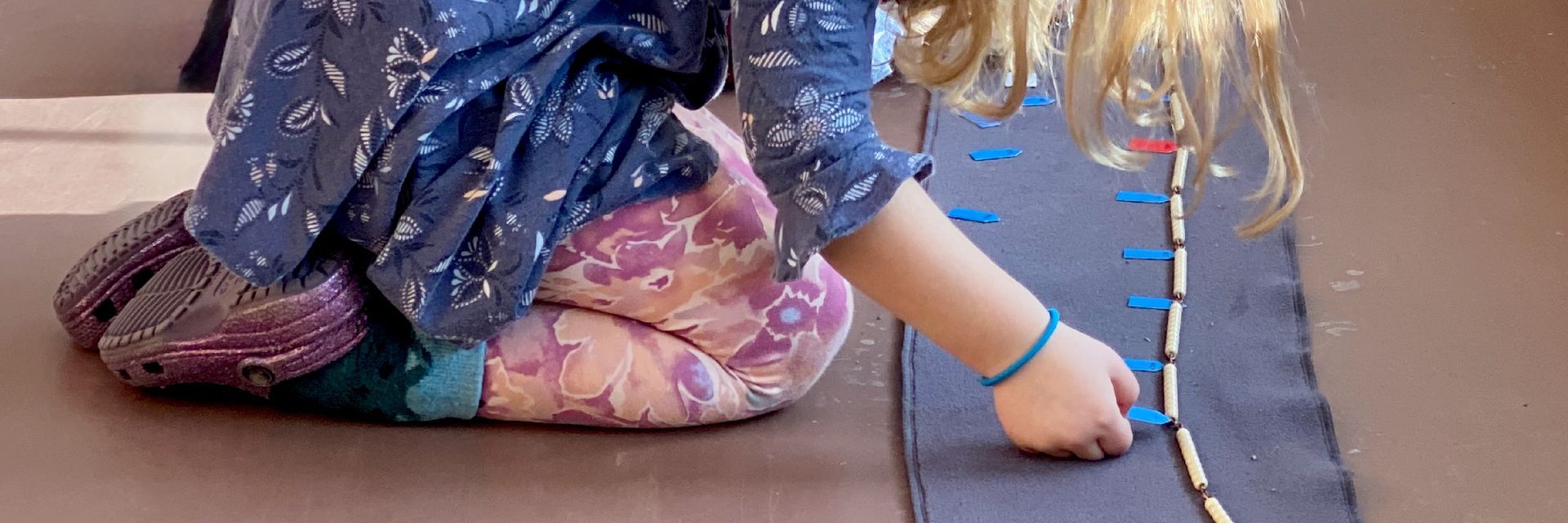Mathematical Foundations

Whether we embrace math or not, humans have a tendency to think in patterns, quantify, and make logical connections. Some even say we have a mathematical mind! Young children also have this innate ability and inclination, so in Montessori, we take advantage of this propensity for mathematical thinking and offer learning experiences that provide an in-depth understanding of math even at a young age.
Organized into six general groups, the mathematical exercises in the Children’s House span from a foundational understanding of the numbers one to ten, to working with very large numbers and place value within our decimal system, to internalizing number facts, and even early work with fractions!
Numbers 1 to 10
Although learning the numbers 1 to 10 sounds simple, it actually involves the integration of several distinct concepts. The beauty of the Montessori materials is that they isolate each separate concept so that children’s understanding grows in progressive steps. This first group of exercises in the Children’s House aims to teach the names, symbols, quantities, and sequence for the numbers 1 through 10.
The youngest children first use the number rods, which are color-coded with alternating red and blue sections to designate the quantities of one through ten. As children work with the number rods, they solidify the concept of quantity as a single entity while also practicing one-to-one correspondence.
The sandpaper numbers help children learn the symbolic representation of numbers. After children master the sandpaper numbers and can easily identify numerals, we help them connect the number cards with the corresponding number rods. Additional materials–like the spindle boxes, cards and counters, and the memory game–help children progress from understanding quantity as a single entity to grasping how quantity can be a set.
Throughout this progression, we offer experiential exercises to help children learn the concepts of addition, subtraction, multiplication, and division. At this stage, we don’t provide the vocabulary but rather give an impression of the concept of each operation.
The Decimal System
Once children have mastered the numbers 1 to 10 activities, they are ready to begin exercises with the golden beads. Because there are never more than nine in a given place value, and children already know the quantities and the symbols, they are ready to learn the hierarchy of units, tens, hundreds, and thousands.
As children set up the golden beads, the primary decimal system materials, they learn how to think through the process of each operation and the concepts of calculation. Are they putting quantities together or taking them apart and recounting the categories?
The decimal system work gives children knowledge of the mathematical processes and solidifies their understanding of the mechanics of the decimal system. We focus on helping children understand the process of each operation. We aren’t looking for the right answer. We want the child to understand the operations and what adding, multiplying, dividing, or subtracting means.
After children understand the operations with the golden beads, we offer other materials, such as the stamp game and dot game, to help them move away from a very concrete toward a more symbolic representation of the quantities. We offer word problems at the end of this series, which help verify whether children understand each operation's process.
Continuation of Counting
Through this group of exercises, children learn the name, symbol, and quantity of the numbers from 11 to 100, and consolidate linear counting up to 1,000. The work starts with the teen boards (11 through 19) and tens boards (20 to 100). We also introduce the colored bead stair, which gives a color-coded sensorial representation for quantities of one through ten, a pattern replicated throughout the Montessori math materials.
With the golden beads, children experience the difference between 100 and 1,000, by weight and geometrical representation. In continuation of counting, children lay out the bead chains and see the dramatic linear difference between 100 and 1,000. Children also use the bead chains to practice skip counting, which lays the foundation for further studies in multiplication.
We also make sure there is lots of counting in the classroom! Children can be taught to count by rote, but mental maturity helps them take the leap from rote counting to understanding quantities represented by numbers.
Exploration and Memorization of the Tables
Through a variety of materials–the addition strip board, addition snake game, subtraction strip board, subtraction snake game, multiplication bead board, bead bars, and unit division board–children have lots and lots of practice with the essential math facts. This concrete exploration establishes a visual understanding of what something like 5 x 6 looks like and helps children establish early neural pathways for memorizing these math facts.
After children use different forms of bead material to practice, they move into more abstract representations of quantity and eventually even use blank charts to test their memory.
All of the repetition in this exploration phase leads to memorization as children become aware of which combinations they know and which they don’t know. Eventually, after a lot of practice and repetition, children realize that it is faster to do the calculations mentally rather than with the materials.
As children reach the end of their primary years, they want to be more efficient. At precisely this point, they are ready to begin the last group of exercises, called the passage to abstraction.
Passage to Abstraction
In the exercises for passage to abstraction, children connect the skills and concepts from the previous strands of learning, and their knowledge base shifts from understanding the concepts experientially to understanding them logically.
With the small bead frame, children revisit the process of addition and subtraction. With the wooden hierarchy material, children get a sensorial and symbolic introduction to the quantities ten thousand, one hundred thousand, and one million. This material also prepares children for the large bead frame and experiencing the multiplication of large numbers with a single-digit multiplier. The racks and tubes material allows children to begin dividing with larger divisors and dividends. With all of this concrete experience working with larger quantities, children are well on their path to abstraction.
Fractions
The final material in the mathematical progression is fractions. In the Children’s House, we have already helped the youngest children explore fractions sensorially. They return to this material from a mathematical perspective to understand quantities smaller than one unit. In addition, children begin simple operations with the fraction material and start to explore the equivalence of fractions.
In the Children’s House, the progression we use for all of these exercises helps children deeply solidify their mathematical understanding. We first ensure children have strong concrete experiences, followed by more symbolic representations. After children associate the concrete and the abstract, we offer lots of activities for practice, repetition, and verification.
In the process, we support children’s growth in classification, comparison, and reasoning. We invite you to come see children’s mathematical minds in action.
Schedule a tour today!

Contact Us
© 2024 The Montessori School of the Berkshires
PO Box 422, 21 Patterson Road, Lenox Dale, MA 01242









